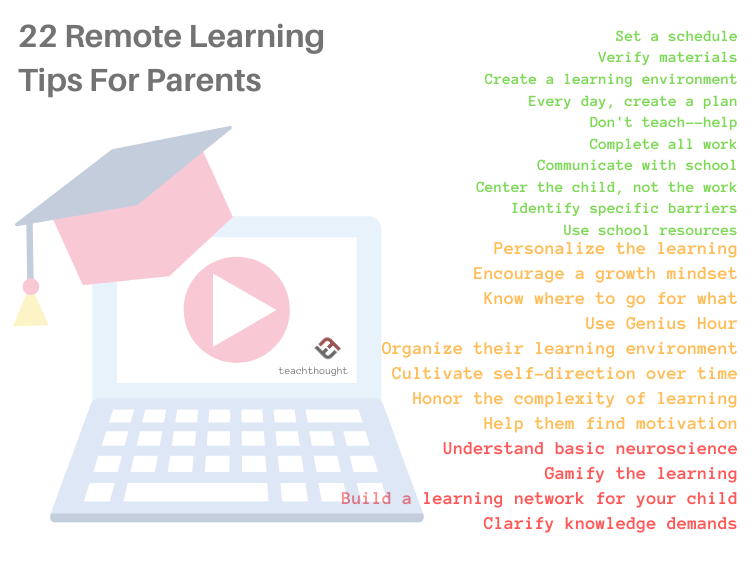How Can Parents Help With Remote Learning At Home?
by Terry Heick
Remote Learning occurs when teachers and students move a normally in-person class to a temporary online space.
It’s a kind of eLearning (or ‘online learning’) but isn’t ‘online learning’ because it is not learning that is designed for purely digital spaces (whereas eLearning is). So what kind of remote learning tips for parents can help? In What Parents Can Do To Help Support Reading At Home, I talked about the ways families can model and support literacy in the home. Below, I offer a continuum of remote learning tips for parents and families (perhaps suddenly) working with children at home.
Three Quick Prefaces
1. These are not meant to be viral tips that blow your mind but rather some basic advice to save your sanity and help your child have their best chance for success learning at home.
2. I’ve arranged it from ‘Basic Remote Learning Tips’ to ‘Advanced Remote Learning Tips.’
The idea of the first set of remote learning tips is to provide bare minimum guidance for parents who are trying to wrap their heads around this shift to online learning in K-12 public education–more or less a, ‘If nothing else, make sure that you…’ approach. If you can imagine car maintenance tips, while some could be very advanced (e.g., make sure the car’s alignment suits the way the car is used on a daily basis, make sure engine management software is updated to the latest version, etc.) an ‘if nothing else’ approach to such maintenance might be, “Make sure the car doesn’t run out of gas’ and ‘Make sure the engine has oil.’
3. As I alluded to in the introduction, a final underlying assumption here is that a curriculum is already set (whether it’s a public education curriculum from your local school district or an off-the-shelf homeschool curriculum). While some of these tips are universal and apply to any learning-at-home scenario, overall this list wasn’t created for parents helping their children learn to learn or learn what to learn, nor would this post be much help if you’re trying to create your own customized curriculum for your child. Again–these tips are mainly to help parents who are helping their children complete online learning assignments at home.
With that in mind, on to the tips.
22 Remote Learning Tips For Parents
Bare Minimum: These are intended to be a set of basic tips that are true for most remote learning situations.
1. Set (and keep) a schedule
The closer this is to a ‘school schedule,’ the easier it will likely be on everyone. You obviously can (and probably should) revise whatever you come up with at first to fit your circumstance at home (your work schedule, sleeping schedules, etc.). But once you’ve got something that works, stick to it. And this almost certainly means to use some sort of timer to at least clarify how much time is being spent on what.
2. Make sure they have any materials necessary to complete all assignments
Whether its pencil and paper, a stable WiFi connection, log-in information for all accounts, a PDF reader, or note-taking apps or reading strategies–whatever they need to get the work done.
3. Provide an environment conducive to learning
This isn’t always easy. If they’re too isolated, it’s difficult to check in with them. If they’re at the kitchen table, depending on the child or their environment, they may be too distracted. This is even more challenging when everyone is home and the house is full.
Background noise can help, as can music.
4. Create a daily plan
Creating a daily plan isn’t just a matter of scheduling. A daily plan looks at the schedule and then identifies to-do items for that day and combines the two for a specific plan for that specific day.
5. Don’t teach–help them understand
Helping students understand is one of the more obvious remote learning tips for parents. This could be the topic for an entire book because how this happens is complicated and varies greatly from student to student and grade level to grade level and content area to content area.
Imagine the parent of a second-grade student helping them complete an essay on their favorite cookie versus the parent of a high school senior helping them with a Calculus problem or an analysis of Shakespearean versus Petrarchan meter. The former is a matter of sitting with your child, while the latter is going to likely require that you learn alongside your child–or even learn it first yourself and then review it with them after.
The bottom line is that helping your child understand the content is definitely part of the ‘bare minimum’ range of tips.
6. Make sure all work is completed
And any work that remains incomplete is incomplete for a good reason and has a time-bound, actionable next-step (e.g., email the teacher asking for clarification on step 3 of the activity so that you can turn it in tomorrow by noon).
7. Help them check messages and communicate with school
Check for messages daily from teachers and other students and make sure to reply to any messages that require one.
8. Keep in mind that it’s about the child, not the work
This can be difficult for some parents to keep in mind when there is so much pressure (on everyone) to complete the work. And further, this is obviously a parenting philosophy–for some families, it very well may be a matter of discipline to do what you’re told and ‘do well in school.’ If that’s true, this tip may not be useful.
But if you believe that assignments should serve the child rather than the child serve the assignments–or that this is at least partly true–then don’t over-emphasize ‘getting everything done’ over the well-being (not to mention creative genius and curiosity and intrinsic motivation) of your child.
9. Learn to identify the barriers
This is something teachers have to learn early on in their careers–how to pinpoint exactly what’s happening or going wrong (not unlike an automotive mechanic or NASA engineers or computer coder. Diagnostic teaching is one approach that can help here but the big idea is to identify precisely why your child might be struggling: Is it focus? Motivation? Too much or too little structure? Do they need a hug or finger-wagging or for you to sit with them?
And if it’s a knowledge deficit, exactly what do they not understand? When students say, ‘I don’t get it,’ the first step is to identify exactly what ‘it’ is–and this isn’t always easy. Most students don’t know what they don’t know. That’s why you (and an internet full of resources) are there to help them making this an especially powerful remote learning tip for parents.
10. Use school resources
Contact your child’s school, as well as the local school district and state education resources for support. This is especially critical if your child has an IEP or 504 plan and requires additional support and services at school.
Intermediate Remote Learning Tips For Parents
Going the extra mile: Slightly more intermediate tips for parents with the time and resources to dedicate
11. Personalize the learning
You can almost always personalize your child’s learning space (sound, light, room, equipment, etc.) and you can likely adjust their schedule. You may even have some control over the curriculum (what they are learning). Use your child’s strengths and gifts and build backward from them as much as possible.
12. Encourage a growth mindset
This isn’t about what to learn or how to learn but rather how to think about what they’re learning. For a somewhat-related post, you can see ‘Alternatives To Asking Your Child What They Learned In School Today.’
13. Use the right resources
Here are some homeschooling resources that can help, for starters. The idea here is to know where to go for what to save time when you–or your child–need something.
14. Mix in Genius Learning
You can read more about Genius Hour here. The goal is to help empower your child to see learning as something they have control of and that curiosity can lead them anywhere.
15. Organize their learning environment
Or help them organize their learning environments (both physical and digital).
How this happens depends (as with everything else on this list) on your circumstance: Are you using a Learning Management System (LMS)? Are classes meeting live? Daily or weekly? Does your child love learning or has school been a struggle for them? Is there a fixed curriculum? Any flexibility in that fixed curriculum? Are assignments graded? And so on.
Imagine a high school student sitting at a desktop computer in their bedroom logged on to their local school’s LMS. They have their iPad open and Microsoft OneNote open to take notes. Their phone is playing a background noise to help them focus while their physical textbook is open beside the keyboard. They also have their web browser open with multiple tabs open for search, communication, and related learning resources as well as a digital or physical calendar with upcoming due dates for important assignments. And lastly, they have a to-do list and learning plan for that day to guide them.
That’s one example of a ‘learning environment.’
16. Encourage self-direction
This could’ve gone in the ‘basic’ sections complicated but at its most basic, the more they own their learning–and ideally have voice and choice in their work–the easier and more fulfilling everything will be for everyone.
17. Honor the complexity of learning
Think differently about ‘helping’ your child ‘with their school work.’ Realize that your child needs a wide range of ‘support’: academic, collaborative, psychological, technological, disciplinary, etc.
18. Help them find their own motivation
I tried to word this carefully because children range so drastically in not only their levels of motivation and where that motivation comes from. Further, the dynamic of parent-to-child is necessarily different from the parents-as-teacher-to-child.
However, motivating a child is one area where parents are (ideally) better than any teacher could be. The idea here is to help them ‘want to’ learn without punishing them psychologically or making all motivation external and independent from the actual value of the knowledge being gleaned.
Advanced Remote Learning Tips For Parents
Obviously, these would only apple for some remote learning situations but if you’re really ambitious, you could consider trying to do the following:
19. Understand how the brain works and how learning happens
Learning theories and neuroscience basics are two good places to start. Transfer is also an important concept.
20. Gamify the learning
Offer points, levels, challenges, visible markers of progress, etc. You can read more about the definition of gamification here and about how gamification uncovers the nuance of learning.
21. Help your child build a learning network
Connect them with their peers–ideally peers with similar goals and approaches to ‘life’ to their own (e.g., connecting your child who wants to study medicine in college with other students and groups with students who have similar ambitions.)
22. Help them understand the value of specific knowledge and changing knowledge demands
Further, emphasize critical thinking (learning how to think) and learning literacy (learning how to learn) over content knowledge (academic knowledge). This is probably more of a homeschooling tips than a remote learning tip but ideally it would happen in any formal learning scenario.
Remote Learning Tips For Parents

